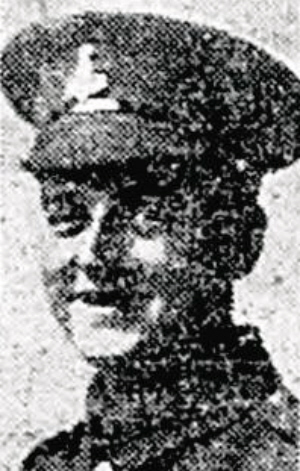
Charles Herbert Almond was born to George Henry Almond and Margaret Elizabeth (nee Swallow ) on 28th August 1898 and baptised at St. Matthew’s Church Dewsbury West Town on 11th January 1899. The couple married in Dewsbury West Town in 1894 and their two children, Edith May and Charles Herbert, were born in Dewsbury. By 1901 the family had moved to Intake Lane, Ossett and by 1911 they were living at Ryecroft Street where they were still living in 1913-14. At some time later his parents, George Henry and Margaret Elizabeth Almond moved to live at 47, Luxor Street, Harehills Road, Leeds.
Charles Herbert Almond’s army service record has not survived but it is known that he enlisted in Leeds and joined the 21st (Tyneside Scottish) battalion Northumberland Fusiliers Regiment probably no earlier than his 18th birthday in late August 1916. At this stage in WWI he should not have been sent overseas until his 19th birthday in late August 1917.
The 21st Battalion (2nd Tyneside Scottish) was formed at Newcastle in October 1914 and came under orders of the 102nd Brigade in the 34th Division which first landed in France in January 1916. The Division was largely comprised of locally raised units often known as “pals”, notably those raised in the north east and known as the Tyneside Scottish and Tyneside Irish. There were also the Manchester Scottish, the Grimsby Chums and others.
It is possible that Charles Herbert joined the Northumberland Fusiliers and the 34th Division between mid/late August1917 by which time the Division was stationed in France. In early October 1917 the Division entrained for Ypres where they spent a week in training in readiness for the Third Battle of Ypres also known as Passchendaele.
On 13th October 1917 the battalion moved to Elverdinghe, a village near Ypres, and the following day, 14th October 1917, “as companies were marching to camp, hostile aeroplanes flew over and dropped bombs causing five casualties. Heavy casualties were inflicted at the same time upon other troops in the vicinity” 1

Above: A WWI Casualty Clearing Station (Courtesy Imperial War Museum).
The “Dewsbury Reporter” carried the following obituary:
“OSSETT SOLDIER DIES OF WOUNDS
On Tuesday Mr. And Mrs. G Herbert Almond , St Elmo’s , York Road, Leeds received news that their only son, Pte. Charles Herbert Almond had died of wounds in a casualty clearing station in France. The deceased soldier and his parents belong to Ossett, and both he and his father were employed by Mr. J.L.Wild, manufacturer, now of Leeds.
His grandmother, Mrs. Swallow, resides at 448 Huddersfield Road, Ravensthorpe. He was 19 years of age, and was at Ravensthorpe on his last leave about five weeks ago, so that he had only been on the Front a week or two. The matron of the hospital writes to Mrs. Almond: “I am sorry to tell you that Pte. Almond, 21st Northumberland Fusiliers, was very badly wounded in the chest, and although everything possible was done, he passed away very peacefully at 4 a.m. on October 16th. He was too ill to realise that he was dying, or to suffer much pain. I told him I was writing to you, and he said I was to give you his love and to say that he was alright. He was buried with military hounours in the cemetery attached, with many of his comrades.”
Charles Herbert Almond is buried at grave reference XI.I.4 Dozinghem Military Cemetery West-Vlaanderen, Belgium. The cemetery is located to the north-west of Poperinge near Krombeke.
In July 1917, in readiness for the forthcoming offensive, groups of casualty clearing stations were placed at three positions called by the troops Mendinghem, Dozinghem and Bandaghem. The 4th, 47th and 61st Casualty Clearing Stations were posted at Dozinghem and the military cemetery was used by them until early in 1918. There are now 3,174 Commonwealth burials of the First World War in the cemetery and 65 German war graves from this period. The cemetery also contains 73 Second World War burials dating from the Allied withdrawal to Dunkirk in May 1940.
Charles Herbert Almond was posthumously awarded the British and Victory medals for his service overseas in a theatre of war. It is the intention to have his name engraved at the Ossett War Memorial alongside the other men and women of The Ossett Fallen.
Thanks are due to Paul Edwards for bringing Charles Herbert Almond to our attention.
References:
1. Regimental War Diary 22nd (Tyneside Scottish) Battalion, Northumberland Fusiliers, 34th Division.